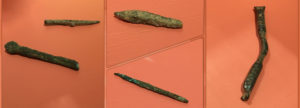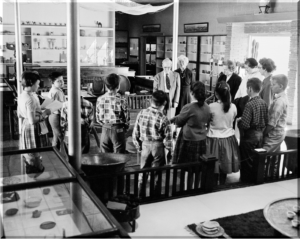Object of the Month: June 2020
Toggle Pins
Bronze
Egyptian, 1648-1540 BC (15th Dynasty)
The Egyptian Pharaohs of the Middle Kingdom (ca. 2030–1650 B.C.) began uniting their country after years of civil war and turmoil. The Middle Kingdom brought increased prosperity and public projects which benefited all the people, not just the ruling class. History shows a variety of people groups took residence in Egypt: prisoners of war, traders, craftsmen, diplomats and more from bordering countries.
However, around 1650 BC, one of the well-established foreign groups of people, known as the Hyksos, rose to power as the 15th Dynasty. These rulers continued to maintain the Egyptian traditions and way of life, which Rosalie David explains in Handbook to Life in Ancient Egypt, “Foreign influence was minimal in the formative years of the society, allowing the distinctive Egyptian traditions to become firmly established. The culture was so all-embracing and pervasive that, when it finally encountered foreign ideas and customs, these were either readily absorbed and Egyptianized or had little or no impact on the mainstream culture.”
Egyptians focused a great deal on their outward appearance. All men, women and children wore some type of make-up both for beautification and protection from the sun. Egyptians emphasized cleanliness often bathing multiple times per day. To discourage lice, both men and women shaved their heads and wore wigs. Egyptian dress even indicated status and social class. Generally, draped and tied pieces of fabric in square or rectangular shapes formed the basic component of Egyptian garments. The most common textile was linen, which was made from flax, spun and woven by women. The linen was a natural, creamy white color or bleached pure white.
At first glance, these simple metal sticks seem insignificant. However, toggle pins served an important function in ancient civilizations. Ancient peoples used toggle pins to fasten garments closed especially cloaks and mantles much like we use buttons, zippers and other fasteners. They were often used to attach fabric at the shoulders, chest and waist. If needed, more than one could be used for added security. The array of foreigners in Egypt explains the presence of toggle pins in Egyptian excavations. The Egyptians most likely imported toggle pins or aimed their production toward Canaanite residents in Egypt since such pins were associated with Canaanite dress.
Bronze toggle pins were most common; however, the wealthy could opt for pins made of gold and silver. On occasion, pins would be formed from bone and ivory. The earliest forms were simple pins with no apparent head, but they evolved into various types such as the nail head, knob head and melon head pins. Some toggle pins contained a hole either for a string to help secure the garment or as a place to hang other decorative objects. Vere Gordon Childe in The Bronze Age: Typology describes how a pin and string were used: “To keep the pin in position a thread was passed through or tied on to its head, looped round the fold of the stuff to be fastened, and the end wound round the shaft again.”
These Toggle Pins are part of M&G’s Bowen Collection of Antiquities. Collectors Frank and Barbara Bowen took an interest in archaeology believing objects from the Holy Land could illuminate their study of the Bible. They completed five trips to the Holy Land in the 1930s-1940s collecting artifacts. They studied and researched at the American School of Oriental Research in Palestine where they met Sir Flinders Petrie, the famous English Archaeologist and Egyptologist. He became not just their teacher but also their friend, and after Petrie’s death, his wife Hilda (an active archaeologist herself) donated a number of Egyptian antiquities to the Bowens’ collection. After completing their travels, the Bowens actively sought a home for their collection eventually donating it entirely to Bob Jones College in Cleveland, Tennessee for a museum. They stayed with the collection as curators. When Bob Jones College became Bob Jones University and moved to Greenville, South Carolina, the Bowens moved as well and continued as curators and docents. Today, these Toggle Pins along with many other artifacts continue to fulfill the Bowens’ goal of “making the Bible come alive” through studying the objects used in the everyday lives of ancient peoples.
Rebekah Cobb, Registrar
Published in 2020



